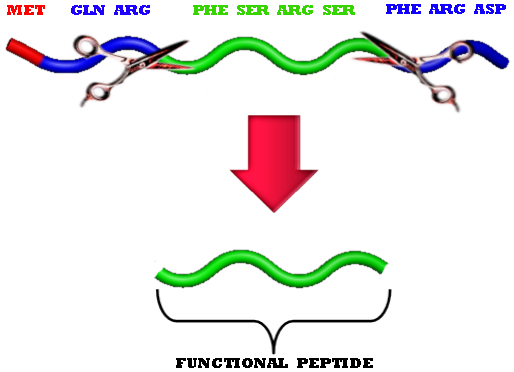Team:Imperial College London/M1
From 2009.igem.org
JamesField (Talk | contribs) (→Peptide Delivery) |
JamesField (Talk | contribs) (→Peptide Delivery) |
||
| Line 25: | Line 25: | ||
When synthesised, all polypeptides begin with the same amino acid: methionine. However, many polypeptides are subsequently chopped into smaller functional peptides that do not begin with methionine. | When synthesised, all polypeptides begin with the same amino acid: methionine. However, many polypeptides are subsequently chopped into smaller functional peptides that do not begin with methionine. | ||
| - | [[Image:MethPep.jpg| | + | [[Image:MethPep.jpg|400px|centre]] |
Unfourtunatly, many peptide processing reactions are unique to the organism in which the peptide naturally occurs. This presents a serious problem: How can <b><i>The E.ncapsulator</i></b> synthesise functional peptides without such complex peptide processing machinery? | Unfourtunatly, many peptide processing reactions are unique to the organism in which the peptide naturally occurs. This presents a serious problem: How can <b><i>The E.ncapsulator</i></b> synthesise functional peptides without such complex peptide processing machinery? | ||
Revision as of 20:31, 16 September 2009

Contents |
 Module 1 Overview
Module 1 Overview
The E.ncapsulator has been designed to produce and deliver polypeptides (amino acid polymers) to the intestine. Module 1 encompasses the polypeptide production phase. During this period, our polypeptide of interest is synthesised at a rate sufficient to faciliate its accumulation inside the cell.
To demonstrate The E.ncapsulator's versatility, we have chosen to showcase it with both enzymes and peptides. These two classes of polypeptide have very different properties that we have considered and catered for in The E.ncapsulator's design.
To learn about the difference between enzymes and peptides, please click on The E.ncapsulator 
Peptide Delivery
Many peptide drugs are suseptible to breakdown in the stomach making them suitable candidates for encapsulation.
However, while a peptide is certainly a lot smaller than an enzyme, its synthesis can be more challenging on account of the 'methionine conundrum'.
When synthesised, all polypeptides begin with the same amino acid: methionine. However, many polypeptides are subsequently chopped into smaller functional peptides that do not begin with methionine.
Unfourtunatly, many peptide processing reactions are unique to the organism in which the peptide naturally occurs. This presents a serious problem: How can The E.ncapsulator synthesise functional peptides without such complex peptide processing machinery?
To enable The E.ncapsulator to produce peptides without inhibiting their functionality, we have developed a removable linker region that starts with the amino acid methionine. Following the release of the peptide in the intestine, a naturally occuring enzyme (enteropeptidase) removes the linker region from the front of the peptide releasing the remainder in its functional form. The use of this linker region can be extended to any polypeptide that does not begin with methionine.
To showcase peptide delivery, we have chosen the pentapeptide (five amino acids)+++++++++. This represents the first iGEM entry to provide a treatment for pain, arousal and depression.
Enzyme Delivery
In the stomach, enzymes face two forms of assalt. The first is protease degradation and the second is denaturation. The high sensitivity of enzymes to these two forms of attack have made them challenging molecules to deliver to the intestine.
Enzymes = acid protection for 3d conformation
- Protein value = PAH = metabolic subcontraction from liver. Treatment for a genetic disease.
- Innovation = SDR for protease resistance
- Protein value = Cellulase = increase microbiome functionality
Cellulase

Cellulose is a compound that is abundant in the human diet - it is what is commonly referred to as 'dietary fibre.' However, the human body is unable to degrade cellulose into glucose naturally, as it lacks the enzymes required to break down this fibrous material.
Cellulase is an enzyme that breaks down cellulose to glucose. By engineering The E.ncapsulator to produce this enzyme and delivering it to the small intestine, we would give the consumer the ability to digest dietary fibre. This would allow more energy and nutrients to be extracted from food; that which was previously unavailable.
More information on cellulase can be found here
Phenylalanine Hydroxylase
Phenylketonuria is a digestive disorder caused by an inability of the body to break down the amino acid phenylalanine. The amino acid accumulates in the blood, and can cause serious health problems for afflicted individuals. Current treatments for the condition revolve around following a strict very low protein diet.
Phenylalanine Hydroxylase (PAH) is an enzyme that breaks down the amino acid phenylalanine into tyrosine. By introducing this enzyme into the digestive system with The E.ncapsulator's unique drug delivery mechanism, we hope to treat the sufferers of PKU.
To find out more about phenylketonuria and PAH, click here.


| Next > Module 1: Genetic circuit |
 "
"






